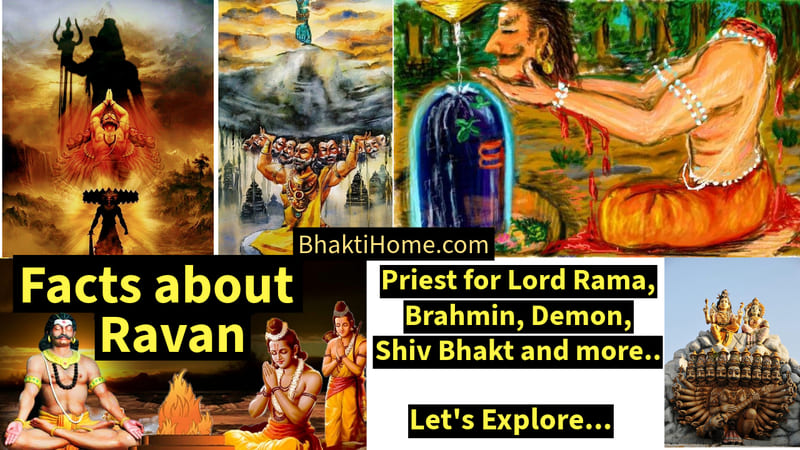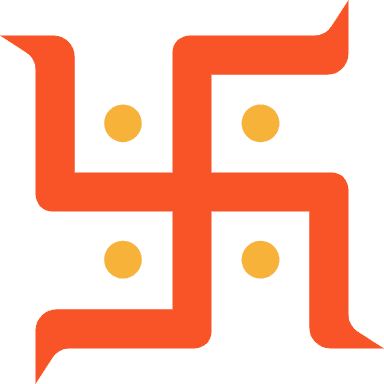
Facts about Ravana
In this blog we will discuss amazing facts about Ravana. While Dussehra is commonly known as a festival commemorating the triumph of good over evil, it serves as just a small fragment of Hindu mythology. Within this vast tapestry, Ravana emerges as a pivotal character, often typecast as a villain but encompassing a far more complex persona. Ravana takes center stage as the principal antagonist in the Hindu epic Ramayana. Despite being widely despised, his multifaceted character remains obscured from many who may overlook his profound wisdom, unwavering determination, and significant achievements.
Ravana's unwavering devotion to Lord Shiva sets him apart. In religious texts, he is described as an incredibly potent demon king, notable for his ten heads symbolizing mastery over the six shastras and the four vedas, showcasing a profound understanding of ancient knowledge and wisdom. Let's explore amazing Facts about Ravana.
1 - Ravana, the Brahmin, Priest for Lord Rama
Out of several Facts about Ravana this one holds at number one position.
Ravana, surprisingly, played a unique role during Lord Rama's mission to construct the Rama Sethu. He served as a Brahmin priest, conducting the necessary rites for this bridge-building endeavor.
Lord Rama, in his quest for victory against Ravana, aimed to establish a Shivalinga and offer worship to gain divine favor. However, a skilled priest was needed for this sacred task, and the region of Rameshwaram lacked qualified priests at that time. Lord Rama faced a pressing need for a proficient priest to conduct the rituals.
Interestingly, Ravana, known for his unwavering devotion to Lord Shiva and his Brahmin lineage, possessed the requisite expertise. Vibhishana, Ravana's brother who had aligned with Lord Rama, conveyed this information to Lord Rama. Subsequently, an invitation was extended to Ravana, requesting him to preside as the priest for the auspicious ceremony in Rameshwaram.
In a display of magnanimity, Ravana accepted the invitation and conducted the worship rituals.
For the sacred ritual, it was imperative that both husband and wife be present together. In this scenario, Rama acted as the yajman, the one performing the religious ceremony, while Ravana assumed the role of the pandit or priest.
Faced with this situation, Rama discussed the requirement with Ravana and inquired if there were any viable alternatives. Ravana, a devout follower of Lord Shiva, staunchly held that there were no substitutes or alternatives in such matters.
A unique agreement was then reached between them. Ravana brought Sita from Lanka to participate in the pooja and subsequently returned her to Lanka. Following the completion of the ceremony, in accordance with customary rituals, it was customary for the yajman to seek blessings by touching the pandit's feet.
Following the ceremony, Ravana bestowed a blessing upon Lord Rama, uttering the words, "Vijayi bhavaha" (May victory be yours!).
When Sita respectfully touched Ravana's feet, he pronounced the words, "Saubhagyavati bhava," signifying a blessing for her to lead a life filled with happiness and good fortune.
This reveals the remarkable depth of Ravana's character. Note - This story is not mentioned in Ramcharitmanas (By Tulsidas ji), Valmiki Ramayan or Adhyatma Ramayan. This is based on tales.
2 - Ravana's Unique Lineage: Half-Brahmin and Half-Demon
Ravana, the ten-headed demon king of Lanka, was a complex figure.
His father, Vishwashrava, belonged to the Pulastya clan of sages, while his mother, Kaikasi, was from a demon clan.
Ravana's family included Kuber, the God of wealth (born to his father's first wife), and Ravana himself, along with his siblings Kumbhakarna, Shurpanakha, and Vibhishana (all born to Kaikasi).
Ravana and his brother Kumbhakarna's penance led to them gaining extraordinary powers from Lord Brahma, which they used to oust Kuber and take control of Lanka.
3 - Transformation of Dashagriva into Ravana - From Lord Shiv ji
Initially known as Dashagriva or Dashanana, which means 'with ten heads,' Ravana's name underwent a transformation.
During an incident where he attempted to dislodge Mount Kailash, Lord Shiva pressed the mountain with his foot, inadvertently crushing Ravana's forearms.
In immense pain, Ravana let out a roar, earning him the name "Ravana," signifying 'one who roars or screams.' Subsequently, Ravana became a devout follower of Lord Shiva and composed the famous Shiva Tandava Stotram. Pleased with his devotion, Lord Shiva gifted Ravana an invincible sword named Chandrahasa.
4 - Extraordinary Veena player
Ravana possessed remarkable musical talents and was known for his extraordinary skills as a veena player. Numerous representations of Ravana often depict him carrying a veena, underscoring his deep passion for music and his remarkable proficiency as a veena maestro.
Furthermore, Ravana's musical prowess extended to the creation of his own unique string instrument, known as the "Ravana Veena." He was also credited with inventing the bow of the violin, contributing to the evolution of musical instruments.
Ravana's musical legacy went beyond instrumental craftsmanship; he is credited with introducing the very first Ragas, a significant development in Indian classical music. Notably, he composed the renowned "Shiv Tandav," a valuable work that extolled the virtues of Lord Shiva through music.
5 - Ravana as Physician / Vaidya Shiromani
Ravana was not only known for his prowess in various fields but also as a distinguished Ayurvedic physician, earning the title of Vaidya Shiromani. His contributions to the field of medicine were extensive, and he authored several valuable texts, shedding light on various aspects of healthcare.
Among his notable works were "Nadi Pariksha," a comprehensive treatise on the examination of pulses, and "Arka Shastra," a compilation that detailed the usage, dosages, and remedies for a wide range of herbs, particularly for treating complex diseases. His expertise extended to the realm of tinctures and extracts, which he elaborated upon in "Arka Pariksha."
In the domain of healthcare for women and children, Ravana's "Kumara Tantraya" focused on gynecology and pediatric medicine. His contributions also encompassed texts like "Uddisa Chiktsaya," "Oddiya Chikitsa," and "Vatina Prakaranaya."
Ravana's pioneering efforts extended to the creation of "SINDHURAM" medicine, a remarkable remedy renowned for its ability to instantly heal wounds and injuries.
6 - Great-grandson of Brahma
From a genealogical perspective, Ravana can be traced back as the great-grandson of Brahma. His father, the renowned sage Visravas, was the son of Prajapati Pulastya, one of the ten 'mind-born' sons of Brahma. There is chaupai which depicts this.
उत्तम कुल पुलस्ति कर नाती। सिव बिंरचि पूजेहु बहु भाँती॥
बर पायहु कीन्हेहु सब काजा। जीतेहु लोकपाल सब राजा॥
Uttam kul pulasti kar Naati, Siv binrachi poojehu bahu bhanti.
bar paayahu keenhehu sab kaaja. jeetehu lokapaal sab raaja.
Meaning - You have a noble family, you are the grandson of sage Pulastya. You have worshiped Shiva and Brahma in many ways. Got a boon from him and accomplished all the tasks. You have conquered the Lokpalas and all the kings.
7 - Ravana and his brother Kumbhakarna were, in fact, Avatars of Vishnu's gatekeepers
Ravan and his brother Kumbhkaran were originally known as Jaya and Vijaya, the gatekeepers of Lord Vishnu. This role led to a certain arrogance in them. Once, when the four Kumaras, mind-born sons of Brahma, arrived at the gates of Vaikunth, Vishnu's abode, Jaya and Vijaya mistakenly perceived them as naked children, a result of their deep meditation. This misunderstanding greatly angered the sages, who then cursed Jaya and Vijaya, decreeing that they would be separated from their lord.
Seeking forgiveness, Jaya and Vijaya were given two options by the sages: they could either spend seven lifetimes on Earth as allies of Vishnu's avatars or three lifetimes as their adversaries. They chose the latter, and in one of those three lifetimes, they were reborn as Ravan and Kumbhkaran.
8 - The Curse of King Anaranya and Dussehra
Ravana's confrontation with the Ikshvaku dynasty, to which Lord Rama belonged, had consequences. King Anaranya of the Ikshvaku dynasty, before his death, cursed Ravana, predicting that he would eventually meet his end at the hands of a son of King Dasaratha. This curse underlines the significance of Dussehra, marking Lord Rama's victory over Ravana.
9 - Ravana and His Encounter with Bali (Vali)
Ravana's encounters extended beyond his rivalry with Lord Rama.
When he attempted to kill the powerful monkey king Bali, who was in deep meditation to the Sun God on a seashore, Bali (Vali) captured Ravana and brought him to Kishkindhya. However, their animosity turned to friendship. Bali eventually met his end during a battle with Lord Rama, while fighting alongside Sugriva.
10 - Ravana's Multifaceted Knowledge: Vedas, Astrology, and Saturn's Maiming
Ravana wasn't just a formidable warrior but also an expert in the Vedas and astrology.
Legend has it that he meticulously aligned the planets and the Sun to ensure an auspicious 'lagna' for the birth of his son Meghanada. However, when Saturn disrupted the alignment, Ravana attacked the planet, maiming it for life.Ravana's Mastery of Statecraft
Ravana was also known for his proficiency in statecraft. When Lord Rama defeated Ravana, he instructed his brother, Lakshmana, to learn the art of statecraft and diplomacy from the dying demon king.
11 - Ravana's Boon and Vulnerability
After a thousand years of penance, Ravana sought a boon for immortality from Lord Brahma. However, Brahma granted him the boon that his life would be concentrated at his navel.
Ravana's brother, Vibhishana, a devotee of Rama, revealed this vulnerability. During the epic battle, Rama aimed his arrow at Ravana's navel, ultimately leading to the demon king's demise.
12 - The Boon that Led to Ravana's Fall
Ravana acquired a boon from Lord Brahma, believing that no god, demon, kinnar, or gandharva could ever kill him.
Little did he know that the boon did not protect him from human beings, and it was Lord Rama, in his human form, who ultimately defeated and killed Ravana.
13 - Ravana's Ambitions: Lanka and the Pushpaka Vimana
Ravana's ambitions extended to usurping both Lanka and the golden Pushpaka Vimana, a celestial aircraft known for its ability to change shape and travel at incredible speeds, akin to the speed of thought.
14 - Ravana having own private jets (Vimana)
While the Pushpak Vimana, which Lord Rama utilized to transport Sita following her rescue, is well-known, what remains relatively obscure is Ravana's possession of multiple such aircraft and the presence of designated landing sites. Several locations in Sri Lanka, such as Weragantota in Mahiyangana, Thotupola Kanda in Horton Plains, Wariyapola in Kurunegala, and Gurulupotha in Mahiyangana, are still identified as "airports" that Ravana used.
According to legend, Ravana had a flying chariot, the Pushpak, which he used to transport Sita to Lanka. This suggests that Ravana's wealth allowed him to have his own private "jet."
15 - Ravana Samhita author
The Ravana Samhita, authored by Ravana. This is a compilation of secrets and principles that were imparted to him by Lord Shiva. Within the Ravana Samhita, Ravana has documented numerous Vedic and Tantric remedies. These remedies, when executed with unwavering devotion, have the potential to empower individuals and provide them with control over significant aspects of their lives, such as wealth, success, health, and fame.

